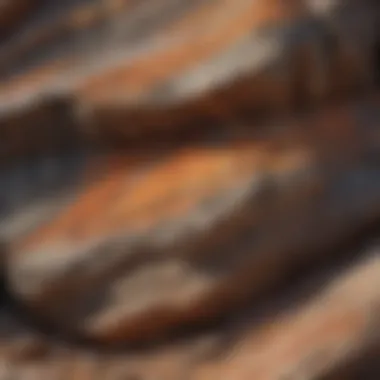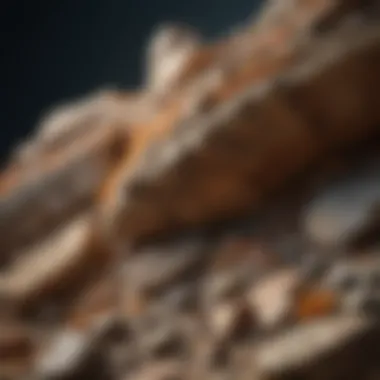Dive Deeper into the World of Rock Minerals with This Comprehensive Guide


Rock and Fossil Identification
In the realm of rock and fossil identification, understanding the various types and their defining characteristics is fundamental for collectors. Rocks and fossils come in a multitude of forms - from the rugged beauty of igneous rocks to the intricate layers of sedimentary rocks and the transformative nature of metamorphic rocks. Each type encapsulates a unique tale of its geological journey, making it crucial for collectors to discern these distinctions. To identify rocks and fossils effectively, collectors should observe key features such as color, texture, grain size, and mineral composition. Utilizing tools like magnifying glasses, hardness picks, streak plates, and UV lights can aid in the identification process, revealing intricate details that might go unnoticed by the naked eye.
Collecting Tips and Techniques
Mastering the art of collecting rocks and fossils requires a combination of skill, patience, and knowledge. The first step is to research and identify prime collecting sites, which often boast a rich diversity of specimens waiting to be discovered. Whether exploring rocky terrains, riverbeds, or ancient quarries, being equipped with the right tools is essential. Geology hammers, chisels, brushes, and protective gear ensure a safe and productive collecting experience. When extracting specimens, it is crucial to handle them with care to avoid damaging their delicate structures. Implementing best practices such as documenting the collection location, labeling specimens, and seeking appropriate permissions is crucial for responsible collecting.
Preservation and Display
Preserving collected rocks and fossils is vital to maintaining their integrity and longevity. Techniques such as cleaning specimens with gentle brushes and water, stabilizing fragile pieces with consolidants, and protecting them from exposure to humidity and sunlight are key to preservation. Proper storage methods involve storing specimens in archival-quality containers or display cases to shield them from environmental factors that could lead to degradation. When it comes to displaying your collection, creativity knows no bounds. From classic showcases to thematic arrangements, assembling rocks and fossils in visually appealing presentations can enhance their beauty and educational value.
Geological Insights
Delving into the geological insights offered by rocks and fossils unveils a world of captivating formations and processes. Understanding the geological history behind these specimens provides a glimpse into the Earth's intricate past. Rocks and fossils not only showcase the natural beauty of our planet but also carry significant historical significance. They have played a crucial role in unveiling scientific mysteries and shaping our understanding of the world. Notable discoveries in the field continue to expand our knowledge, offering new insights into the Earth's rich geological tapestry. By exploring geological formations and processes, collectors can forge a deeper connection with the ancient forces that have shaped our planet for millions of years.
Introduction to Rock Minerals
Rock minerals serve as the foundational components of Earth's crust, offering invaluable insights into the planet's geological history. In this article, we embark on a journey to unravel the significance of various rock minerals, aiming to enrich the knowledge and appreciation of rock and fossil enthusiasts. By delving into the intricate details of rock formation, classification, and preservation, collectors can gain a comprehensive understanding of these geological treasures.
Understanding Rock Formation
Formation Processes
Formation processes play a pivotal role in shaping the characteristics of rocks. From volcanic eruptions giving birth to igneous rocks to sediment deposition leading to sedimentary rocks and the transformative forces of pressure and heat manifesting as metamorphic rocks, each process contributes distinct properties to the rocks. Understanding these formation processes is essential for discerning the origin and composition of different rock minerals.
Influence of Pressure and Temperature
The interplay of pressure and temperature during rock formation dictates their final properties. Rocks subjected to high pressure and temperature conditions undergo metamorphism, resulting in unique textures and mineral compositions. The influence of these external forces illustrates the dynamic nature of rocks and offers insights into the Earth's geological processes over time.
Geological Timescales
Geological timescales provide a comprehensive framework for understanding the evolution of rocks. By analyzing the age of rock formations and correlating them with geological events, researchers can unravel the intricate history of the Earth. These timescales offer a profound perspective on the vast timespans involved in rock mineral formation and the gradual changes that have shaped the Earth's surface.
Significance of Rock Classification
Scientific Taxonomy
Scientific taxonomy provides a systematic approach to categorizing rock minerals based on their physical and chemical properties. This classification enables researchers to group rocks with similar traits together, facilitating comparative studies and enhancing our understanding of Earth's geology. By employing scientific taxonomy, collectors can identify and classify rocks with precision, enriching their knowledge of the diverse rock mineral kingdom.
Practical Applications
The practical applications of rock classification extend beyond scientific research to various industries. From construction materials sourcing to mineral exploration, categorizing rocks based on their properties guides decision-making processes. Understanding the practical applications of rock classification empowers collectors to recognize the utilitarian value of different rock minerals and their significance in industrial processes.
Identification Techniques


Accurate identification of rock minerals relies on specialized techniques to differentiate between various specimens. Methods such as mineral analyses, thin section petrography, and X-ray diffraction assist in identifying minerals present in rocks. Mastering these identification techniques equips collectors with the necessary tools to discern the unique features and compositions of different rock minerals, enriching their collection experience.
Types of Rock Minerals
In this article, we delve into the significance of different types of rock minerals, aiming to provide a comprehensive guide for rock and fossil collectors. Understanding the various categories of rocks, including igneous, sedimentary, metamorphic, and exotic minerals, allows collectors to appreciate and expand their knowledge of geological specimens.
Igneous Rocks
Basalt
Basalt, a common igneous rock, plays a pivotal role in our exploration of rock minerals. Its key characteristic lies in its fine-grained texture, making it suitable for detailed study under the microscope. Basalt's significance in this article stems from its frequent occurrence across the Earth's surface, providing valuable insights into the planet's volcanic history. Despite its ubiquity, Basalt offers a unique feature - its dark coloration due to the presence of iron and magnesium minerals, contributing to its distinct appearance.
Granite
Among the igneous rocks discussed, Granite stands out for its granular composition and interlocking crystal structure. This rock type holds immense popularity in this article, mainly because of its widespread use in construction and decorative applications. The key characteristic of Granite is its durability and resistance to weathering, making it a favored choice for rock collectors looking for long-lasting specimens. Despite its heavy weight, Granite's aesthetic appeal and diverse color range make it a valuable addition to any rock mineral collection.
Pumice
Pumice, a lightweight volcanic rock, adds a unique dimension to our examination of igneous rocks. Its porous nature and frothy texture distinguish it from other minerals, offering collectors a distinctive specimen for study and display. The key characteristic of Pumice lies in its ability to float in water due to its high porosity, making it an intriguing choice for enthusiasts interested in volcanic formations. While Pumice's softness can be a disadvantage in terms of durability, its lightness and unique appearance make it a sought-after addition to rock collections.
Sedimentary Rocks
Limestone
Limestone plays a crucial role in our understanding of sedimentary rocks. Its primary significance in this article lies in its abundant fossil content, offering insights into ancient marine life and depositional environments. The key characteristic of Limestone is its effervescence when exposed to acid, aiding in its identification and distinguishing it from other rock types. While Limestone's susceptibility to erosion may be a disadvantage, its rich history and diverse applications, from architecture to agriculture, make it a versatile and intriguing choice for collectors.
Sandstone
Sandstone, characterized by its sandy texture and layered appearance, contributes uniquely to our exploration of sedimentary rocks. Its key characteristic lies in the variety of colors and patterns resulting from different mineral compositions, providing collectors with a visually appealing and diverse range of specimens. Sandstone's adaptability for use as building material and its prevalence in geological formations make it a valuable choice for collectors interested in both aesthetics and geological history.
Shale
Shale, a fine-grained sedimentary rock, offers valuable insights into Earth's history and geologic processes. Its key characteristic lies in its ability to split into thin layers, indicating its formation in calm depositional environments such as lakes or deep ocean basins. While Shale's tendency to weather easily may pose a challenge in preservation, its abundance and significance as a source of fossils and hydrocarbons make it a compelling addition to rock collections.
Metamorphic Rocks
Marble
Marble stands as a prominent member of the metamorphic rock group, renowned for its beauty and versatility. Its key characteristic lies in its distinctive veining patterns and smooth texture, making it a prized choice for sculptors and architects throughout history. Marble's contribution to this article stems from its widespread use in art and architecture, reflecting both elegance and durability. Despite being prone to scratching and staining, Marble's timeless appeal and varied color options create a sense of luxury and sophistication in any collection.
Quartzite
Quartzite, a hard and durable metamorphic rock, adds sturdy elegance to our examination of rock minerals. Its key characteristic lies in its high quartz content, imparting strength and resistance to heat and chemical weathering. Quartzite's appeal in this article is enhanced by its wide range of colors and patterns, offering collectors a unique and enduring choice for their mineral collections. While Quartzite's hardness may pose challenges for carving or shaping, its striking appearance and ability to withstand environmental pressures make it a valuable addition to any discerning collector's showcase.
Schist


Schist, a foliated metamorphic rock, brings a sense of complexity and history to our discussion of rock minerals. Its key characteristic lies in its foliation, creating intricate layers and textures that mesmerize collectors and geologists alike. Schist's importance in this article lies in its role as a marker of tectonic forces and regional metamorphism, providing evidence of Earth's dynamic processes. While Schist's tendency to cleave easily may require careful handling, its diverse mineral composition and geological significance make it a captivating addition to collections seeking depth and diversity.
Exotic Rock Minerals
Obsidian
Obsidian, a volcanic glass formed rapidly by cooling lava, presents a unique and enigmatic addition to our exploration of rock minerals. Its key characteristic lies in its glossy luster and smooth, glassy texture, reminiscent of ancient tools and artifacts. Obsidian's allure in this article stems from its historical and cultural significance, as well as its use in modern jewelry and ornamental pieces. While Obsidian's lack of crystalline structure may limit its appeal to some collectors, its connection to volcanic events and sharp edges make it a captivating and distinctive choice for those interested in rare and enigmatic specimens.
Fluorite
Fluorite, a colorful and fluorescent mineral, captivates our attention with its vibrant hues and light-reactive properties. Its key characteristic lies in its cubic crystal structure and range of colors, from transparent to translucent, creating stunning visual displays in mineral collections. Fluorite's appeal in this article is heightened by its use in optical instruments, as well as its significance in the jewelry and metaphysical industries. While Fluorite's relative softness may require precautions in handling and storage, its beauty and metaphysical associations make it a sought-after gem for collectors seeking both aesthetic pleasure and spiritual connections.
Labradorite
Labradorite, a feldspar mineral known for its iridescent play of colors, adds a touch of magic and mystery to our exploration of rock minerals. Its key characteristic lies in its schiller effect, displaying spectral hues when light hits its surface at various angles, creating a mesmerizing display of colors. Labradorite's significance in this article stems from its metaphysical properties and spiritual associations, as well as its use in jewelry and decorative items. While Labradorite's sensitivity to heat and impact may require caution in handling, its enchanting beauty and mythical allure make it a prized addition to collections seeking depth, beauty, and a touch of enchantment.
Geological Significance
In this meticulous exploration of rock minerals, the section on Geological Significance stands out as a cornerstone of understanding the broader implications of these geological formations. Delving deep into the geological significance within the context of this article provides a comprehensive view of how rock minerals shape our Earth's history and ecosystem. By highlighting specific elements such as the Coloration and Texture, Crystal Structures, and Mineral Composition, this section underscores the critical role these characteristics play in identifying and categorizing various rock minerals. Understanding the geological significance not only enriches our knowledge but also provides invaluable insights into the historical processes that have shaped our planet over millennia.
Rock Mineral Characteristics
Coloration and Texture
Coloration and Texture play a crucial role in the identification and classification of rock minerals. The specific hues and patterns present within these minerals offer clues about their formation and composition. Within this article, Coloration and Texture serve as key indicators that geologists and collectors use to distinguish between different types of rock minerals. The unique feature of Coloration and Texture lies in its ability to provide visual cues regarding the mineral's origin, age, and geological processes. While Coloration and Texture enhance the aesthetic appeal of rock minerals, they also aid in scientific analysis and interpretation, making them indispensable aspects of this article.
Crystal Structures
Examining Crystal Structures is essential for understanding the internal arrangement of atoms within rock minerals. The crystalline patterns exhibited by minerals result from their molecular composition and growth conditions. By focusing on Crystal Structures, this article sheds light on the intricate formations that give rise to distinct mineral characteristics. Highlighting the architecture of crystals not only adds depth to the exploration of rock minerals but also offers insights into their physical properties and behaviors. Understanding Crystal Structures enhances the readers' appreciation of the structural complexities present in these geological wonders.
Mineral Composition
The Mineral Composition of rock minerals encompasses the variety and proportions of minerals present in a given specimen. Comprehending the Mineral Composition is crucial for identifying and classifying rocks based on their predominant minerals. This aspect is highlighted in the article to underscore how different compositions yield diverse rock types with varying properties. Describing the distinctive features of Mineral Composition provides collectors and geologists with essential information to differentiate between rocks and understand their geological significance. Exploring the mineral makeup not only enriches the study of rock minerals but also underscores their scientific and practical value in various applications.
Environmental Indicators
Geological Ages
Geological Ages plays a vital role in deciphering the timelines and historical contexts of rock formations. By examining the geological ages of different rock minerals, researchers can uncover crucial insights into the Earth's evolutionary processes and environmental changes. This article emphasizes the significance of Geological Ages as a key environmental indicator that helps in dating and correlating rock layers, thereby offering valuable information about past geological events. Understanding Geological Ages enriches the understanding of rock mineral formations and their implications on Earth's geological history.
Depositional Environments
The examination of Depositional Environments offers valuable clues about the conditions under which rock minerals were formed. By focusing on the environments where sedimentation took place, geologists can infer the depositional processes and settings that shaped various rock types. Discussing Depositional Environments in this article unveils the intricate interplay between geology and environmental factors, highlighting how specific conditions give rise to distinct rock formations. Exploring these environments enhances the readers' comprehension of rock mineral origins and enriches their knowledge of Earth's dynamic geological processes.
Tectonic Activities


Tectonic Activities are fundamental in shaping the Earth's crust and influencing the formation of rock minerals. This section elucidates how tectonic movements, such as plate collisions and volcanic eruptions, impact the creation and transformation of rocks. By highlighting Tectonic Activities, the article underscores how geological forces shape rock mineral structures and compositions over time. Exploring these activities provides critical insights into the mechanisms driving geological changes and the evolution of Earth's surface. Understanding the role of tectonics contributes significantly to unraveling the geological significance of rock minerals and their broader implications in Earth sciences.
Collecting and Preserving Rock Minerals
In this article, the section on Collecting and Preserving Rock Minerals plays a crucial role in imparting essential knowledge to rock and fossil collectors. Highlighting the significance of preserving these geological treasures is paramount for enthusiasts to maintain the integrity and longevity of their collections. Understanding the best practices for collection and preservation not only enhances the aesthetic appeal of the specimens but also retains their scientific value over time.
Best Practices for Collection
Ethical Sourcing
Ethical sourcing stands out as a cornerstone aspect within the realm of collecting rock minerals. Its emphasis on sustainable and responsible procurement aligns perfectly with the principles of this article. By choosing ethically sourced specimens, collectors contribute to conservation efforts and support local communities involved in mineral extraction. The unique feature of ethical sourcing lies in its ability to ensure the ethical treatment of miners and the environment while providing collectors with authentic and ethically acquired specimens.
Documentation
Documentation serves as a vital component in the world of rock mineral collection and preservation. Detailed record-keeping of acquisition sources, locations, and context not only adds value to the specimens but also aids in scientific research and authentication. Emphasizing the importance of documentation in this article underscores its role in maintaining the credibility and provenance of each rock mineral in a collection. The unique feature of documentation lies in its ability to chronicle the journey of a specimen, enriching its historical significance.
Storage Techniques
The selection of proper storage techniques is essential for ensuring the longevity and preservation of rock minerals. By carefully considering factors such as humidity, temperature, and light exposure, collectors can prevent deterioration and maintain the pristine condition of their specimens. Storage techniques highlighted in this article offer practical solutions to protect rock minerals from external elements and potential damage. The unique feature of storage techniques lies in their ability to safeguard the integrity and value of each specimen, enhancing their aesthetic and scientific appeal.
Preservation Methods
Preservation methods detailed in this article are instrumental in maintaining the quality and authenticity of rock mineral collections. From cleaning procedures to protective measures and display tips, each aspect contributes to the overall preservation and presentation of specimens for enthusiasts and researchers alike.
Cleaning Procedures
Cleaning procedures are indispensable for removing dirt, impurities, and unwanted residues that accumulate on rock minerals over time. Utilizing appropriate cleaning methods ensures the preservation of the specimens' natural beauty and inherent characteristics. By focusing on gentle techniques and suitable cleaning agents, collectors can rejuvenate the appearance of rock minerals without compromising their structural integrity. The unique feature of cleaning procedures lies in their ability to unveil the true essence of each specimen, highlighting its distinctive features.
Protective Measures
Protective measures encompass a range of strategies aimed at safeguarding rock minerals from potential harm or degradation. Whether through proper handling techniques, protective casings, or environmental controls, these measures play a critical role in preserving the specimens for future generations. By emphasizing the importance of protective measures in this article, collectors are encouraged to take proactive steps in ensuring the longevity and integrity of their collections. The unique feature of protective measures lies in their ability to shield rock minerals from external risks, maintaining their pristine condition for years to come.
Display Tips
Effective display of rock minerals adds a layer of sophistication and allure to any collection. By incorporating suitable display tips, collectors can showcase their specimens in an aesthetically pleasing and informative manner. From lighting considerations to arrangement techniques, the presentation of rock minerals can significantly enhance the viewing experience for enthusiasts and visitors alike. The unique feature of display tips lies in their ability to transform a collection into a visually captivating and educational display, inviting exploration and admiration.
Conclusion
Enhancing Your Rock Mineral Collection
Continued Learning
Continued learning plays a pivotal role in enriching one's rock mineral collection. By engaging in continuous education on geology and mineralogy, collectors can stay abreast of new discoveries, classification techniques, and identification methods. This aspect not only enhances the depth of one's knowledge but also fosters a deeper appreciation for the natural world. Learning about the geological processes that shape rock minerals can significantly elevate the quality and significance of one's collection. While there may be challenges such as staying updated with evolving scientific research, the benefits of continued learning far outweigh any obstacles, making it a crucial element in this article.
Networking Opportunities
Networking opportunities present a valuable avenue for rock and fossil collectors to connect with like-minded individuals, experts in the field, and potential collaborators. By networking within the geological community, collectors can exchange insights, share experiences, and gain access to rare specimens or specialized knowledge. This facilitates a dynamic environment for learning, trading, and even participating in research projects. The ability to network effectively can open doors to unique opportunities for expanding one's collection and contributing to the broader study of rock minerals. While networking requires effort and time investment, the benefits it offers in terms of expanding one's collection and knowledge base make it a worthwhile pursuit within the context of this article.
Exploration of New Specimens
Exploring new specimens is a thrilling aspect of rock mineral collecting that fuels passion and curiosity. By seeking out new samples from different geological regions or geological formations, collectors can broaden the scope of their collections and unearth hidden gems. The process of exploration not only enriches one's collection but also leads to exciting discoveries and potentially rare finds. The thrill of uncovering a unique specimen or adding a new mineral to one's collection is unparalleled, driving enthusiasts to venture into unknown territories. While exploring new specimens may pose challenges such as accessibility to remote locations or the financial investment required, the rewards in terms of discovery and personal satisfaction make it an essential component of this article.







